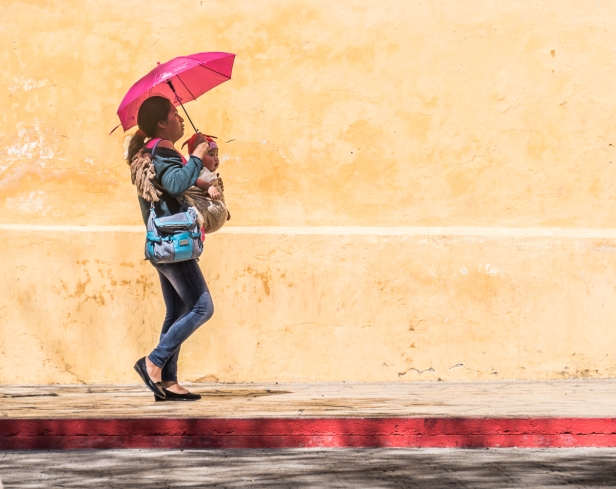
24-29 January 2017. On the first day we climb a broad zigzag staircase to the top of one of the hills that surround the city. It’s a long climb and we rest frequently. We pass some interesting street art,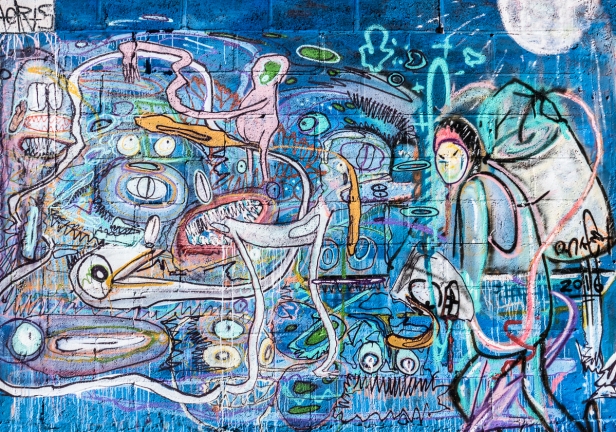
and the views get better the higher we climb until we can see the whole city spread before us. Like water the city spreads out and finds its level between the small hills that punctuate the valley.

San Cristobal de las Casas lies in a small valley surrounded by hills in the Central Highlands of Chiapas. It is one of Mexico’s Pueblos Mágicos and the magic is seen and felt in the red tile roofs, the Spanish Colonial buildings, and the cobblestone streets. There’s a sense of grounded certainty that arises from holding to old traditions and the architecture of another time.


After Oaxaca, the state of Chiapas has the highest concentration of indigenous people in Mexico and for me the magic lies in them as much as in the colonial cobbled streets. There are several Mayan groups in Chiapas, mainly Tzotzils and Tzeltals. They maintain traditions that reach back through hundreds of years: wearing traditional garments, creating by hand many items used in daily life, following a religion that is an inventive mélange of ancient animist and colonial Catholic, and living within tightly knit traditional community and family structures. People know who they are here, and know they belong.
One morning early in our stay we walk to the Cathedral of Saint Christopher, which borders on the main plaza or zocalo. We arrive at the end of an annual religious ceremony and the plaza is filled with people from San Cristobal and the surrounding villages, all wearing the traditional dress of their particular Mayan clan.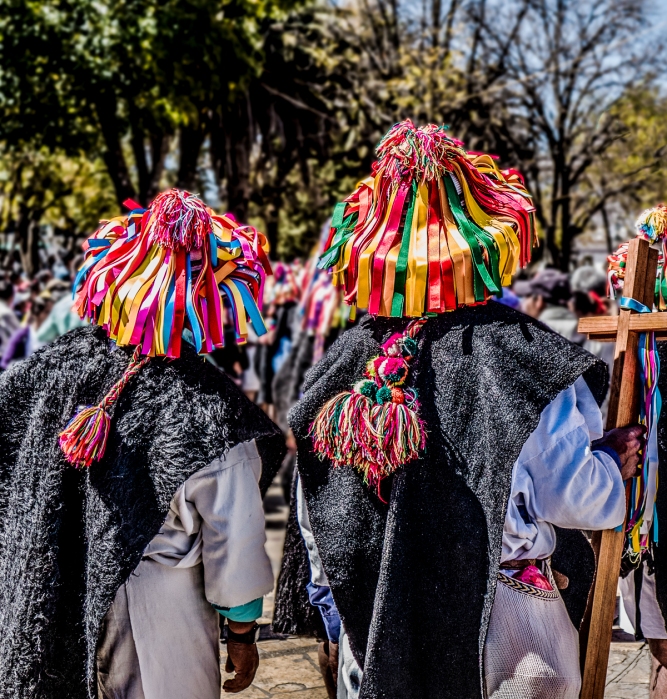



Although this is obviously a special occasion, over the following days it becomes clear that this is also the everyday dress of most of the local people.


The Cathedral and the zocalo are the heart of the town and always the place where people gather by day or night.

Most days we spend some time sitting in the zocalo watching the world go by.

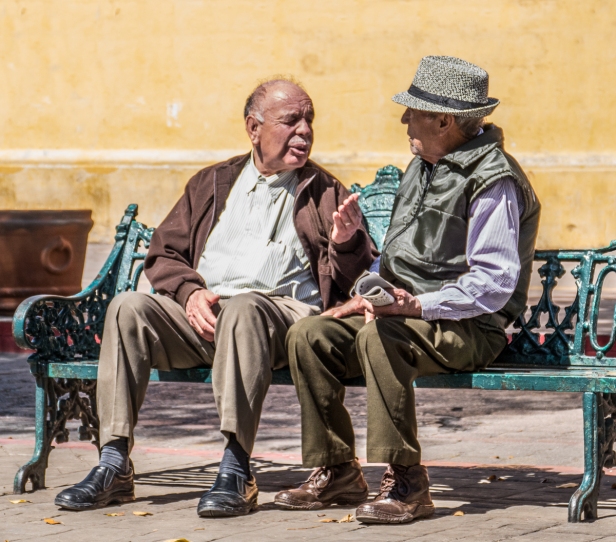
About eight blocks up the hill from the east side of the zocalo is the market. As we walk we pass a man pushing his bright green barrow up the hill. He is selling leather knife pouches and belts. And dangling from the barrow are a baby’s shoe, a child’s shoe, a brass bell, a couple of tote bags, and a colourful half-moon stuffie. 
The closer we get to the market the more we see it spreading out along the street.
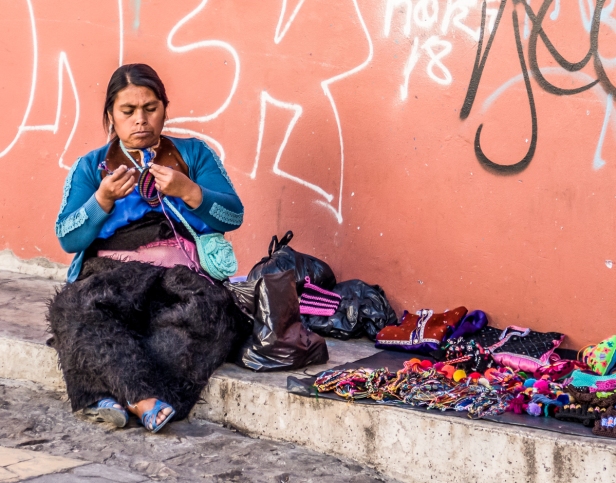
The market is an authentic, colourful, and timeless gathering place. The senses are filled with colours, sounds, and aromas as the people of San Cristobal go about their daily life there. What is ordinary for them is exotic for me. I get a glimpse into their normal.



It is modern in so many ways: electricity, cell phones, plastic bags, buckets, and crates, and yet there is the feeling that nothing has really changed for hundreds of years. Crops are still brought to market, babies are still slung on their mothers’ backs with a shawl, and there is still a sense of the organic growth of it – small stalls pressed close together selling everything you could think of. There are flowers for sale next to dried fish, clothing next to bananas, and children’s toys side by side with oranges and mangoes. You can get shoes and chickens and trinkets and all manner of things I couldn’t identify. Beans and garlic, bags and socks, rope, dried chili, piñatas, and exquisite hand woven and embroidered textiles.



Down the hill a little from the market on Avenida 20 de Noviembre is the Templo Santo Domingo, one of Latin America’s most ornately decorated examples of the colonial Baroque style. On one side there is a crafts market selling an abundant array of local textiles, for which the region is justifiably famous. The craft stalls cascade down the long flight of stairs in front of the Church’s glorious façade.
If you continue on down the hill from Santo Domingo back to the zocalo, and then keep going you’ll come to the main walking street of San Cristobal, Calle Miguel Hidalgo.
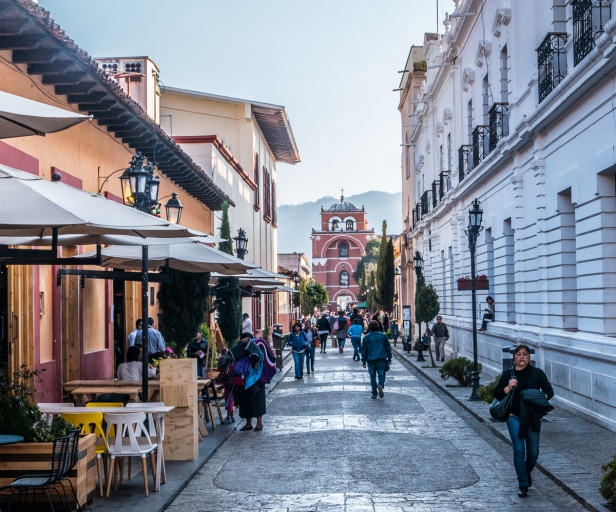
This is a whole other side of San Cris. For several blocks on either side there are restaurants, cafés, and the best patisserie this side of Paris, where most days we eat not pastries (just staring at them is enough to make me drool), but ice cream. We do try the pastries finally towards the end of our stay and they are as good as they look. There is also a very classy café near our hotel where we eat breakfast most mornings.
We find vegetables! There’s not much in the way of vegetables served in Mexico. It’s not a thing here. And we avoid salads (especially lettuce) because of the risk of food poisoning. In Chiapa de Corzo we discovered some delicious tostadas – crispy tortillas topped with shredded lettuce, tomato, avocado, and prawns. We had them twice and felt like we were playing Russian Roulette. Don had them a third time and got the bullet – food poisoning, and then antibiotics to take care of it. After several weeks travelling around the Yucatan by the time we got to San Cris we were desperate for cooked vegetables and found them – a mountain of them on our plates in one of the restaurants on the walking street, and again further down the street at a Japanese restaurant. Their sushi was not so good but the mass of lightly cooked vegetables in teriyaki sauce was fantastic.
On one of our many wanderings we find the orange-juice seller.

The orange is placed in a hand-cranked machine that peels the orange in long thin strips. The strips are used for various crafts including making earrings. The oranges of course are used for making juice.
San Cristobal de las Casas is a wonderful mix of traditional indigenous culture and big city sophistication. It is considered the “cultural capital” of Chiapas. There is a quite large expat population and their influence is apparent. It’s a city where you find patisseries, Japanese, Thai, Italian, and Indian restaurants, and elegant cafés, contrasted with the orange-juice seller and the traditional indigenous population.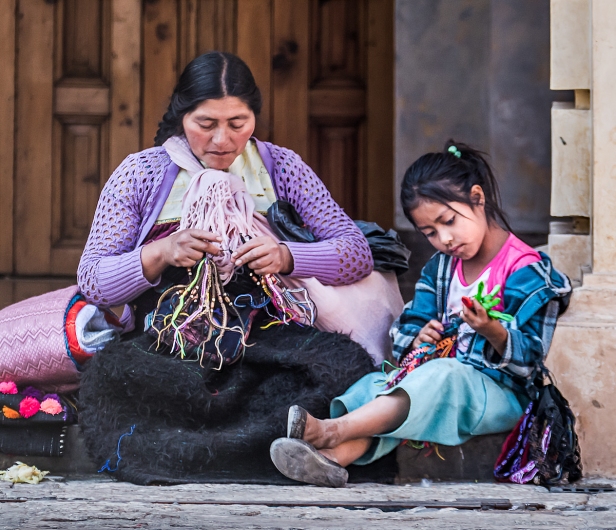
Next post: Another Mayan market, and a truly unique church in San Juan Chamula, one of the villages near San Cristobal.
All words and images by Alison Louise Armstrong unless otherwise noted
© Alison Louise Armstrong and Adventures in Wonderland – a pilgrimage of the heart, 2010-2017.

Good stuff! You’ve got my follow. Check out my comedy blog and give it a follow if you like it!
LikeLike
Thanks so much, I’m glad you enjoyed it. I’ll check out your saucebox 🙂
Alison
LikeLiked by 1 person
Awesome! 😁
LikeLiked by 1 person
Lovely photos. What an interesting and charming pueblo. My favorites, other than the architectural street scenes, are of the two women drinking and the two old men on a bench. I just love, love food markets ~ the buzzing center of so many communities! Thanks for sharing this one.
Peta
LikeLiked by 1 person
Thanks Peta. I love getting shots of the people just being people, doing their thing. And, yes, I’m with you on markets! I never tire of them. It’s the one place for sure that you’ll get a glimpse into the ordinary life of the local people. As usual we were the only tourists there.
Alison
LikeLike
I would submit one of these, maybe the flower market and stalls, to National Geo’s Travel Photo Contest that just opened. I think you can submit more than one. Pick some. I think you have a shot that might win.
LikeLiked by 1 person
I just opened the Nat’t Geo Travel Photo Contest page and see you can submit as many photos as you wish for $15 per photo. I am shocked and appalled! I had no idea Nat’l Geo was this corrupt! So someone can submit 100’s of photos for $15 each???? They increase their odds of winning and Nat’l Geo makes off like a bandit. Yuck! Forget my suggestion. Reputable photo contests shouldn’t charge.
LikeLiked by 1 person
Well first thank you for your endorsement Cindy! That I might win NatGeo contest is high praise indeed. But I agree with you about the price! Wow, that’s pretty steep. I used to put photos in to Shoot the Frame until I got sick of paying the fee ($10 and up depending on how many photos you put in), and the often the winners made no sense. Also I’m not focused on really putting my photos out there just yet. I have a plan/idea/dream that when we stop travelling I’ll delve into all my photos and enter heaps of them in everything (well the comps that don’t charge of course.)
Alison
LikeLike
I feel as I have been there, your photos are so real. You captured it perfectly – the zocalo, the toothless vendor, the chatting women. I was reminded a little of Valparaiso, Chile, with the street art and colorful buildings. Thanks for another great article, Alison and Don.
LikeLiked by 1 person
Thanks so much Helga. There was so much to capture. Everywhere we went I saw things that drew my eye. I often see similarities between the Latin American countries – the Spanish Colonial influence, the undaunted use of colour, the close knit communities, the holding to traditions. We didn’t go to Valparaiso but it wouldn’t surprise me if there were similarities.
Alison
LikeLike
Your post is a time-and-place machine, Alison. As Helga says – you take us right there. The photos of the people are stunning.
LikeLiked by 1 person
Thanks Tish, what a wonderful thing to hear. I love to capture the architecture, and the feel of the town, but for me any town we go to is really all about the people.
Alison
LikeLiked by 1 person
This reminds me so much of Sucre in Bolivia. The clothes, the markets, the mix. Your photos really capture the vibrancy of it all. Terrific.
LikeLiked by 1 person
Thanks Tracey. I’m not surprised to hear it reminds you of Sucre. As I said to Helga, we found many similarities between all the Latin American countries. I still find it exciting to see the markets and the people in their traditional clothes.
Alison
LikeLiked by 1 person
Thanks Alison for bringing back all the magic of San Cristobal de las Casas as we loved our visit there. I remember the bus making the steep climb up the mountains in a circuitous route and feeling the temperature drop as we got higher and higher. At times, I’d look out the window and see the drop to the valley, thousands of feet below, and understood exactly what “my heart in my throat” meant. Your photos, as always, capture the essential essence of both the city and the people. Wonderful! Anita
LikeLiked by 1 person
Thanks Anita. It’s a wonderful city and I’m glad I was able to capture something of the feel of it. We never did that circuitous mountain approach (though I can relate from similar travel experiences). We’d previously been in Chiapa do Corzo which was a fairly short taxi ride away.
Alison
LikeLike
I can imagine myself sitting around the Cathedral and the zocalo for a long time just to watch people do their daily activities. Templo Santo Domingo is a marvelous work of art! The ornate details of the facade are just stunning. No wonder this town is part of the Pueblos Magicos. Beautiful captures of the architecture, the traditional market, and the people, Alison!
LikeLiked by 1 person
Thanks Bama. It was wonderful sitting in the zocalo watching the passing parade. And yes, it’s definitely deserving of the Pueblo Magico designation. I always love the local markets!
Alison
LikeLike
Great shots, top to bottom. I particularly liked the bicycle vendor. The markets reminded me of Cuzco, Peru (including the “bullet”).
LikeLiked by 1 person
Thanks Dave. The bicycle vendor is also one of my favourites. I love the local markets, and certainly found a lot of similarity between almost all of the Latin American markets – all so vibrant and colourful.
Alison
LikeLiked by 1 person
We will definitely need to go back to Mexico to visit San Cristobal. Your images are just amazing Alison. You capture the essence of an area in each and every photo.
LikeLiked by 1 person
Thanks LuAnn. I’m glad my post has inspired you to want to go there. So many of the places we’ve visited have been because of things I’ve seen and read on other peoples’ blogs.
Alison
LikeLiked by 1 person
Everything is so vibrant! I especially love how you’ve captured the people.
LikeLiked by 1 person
Thanks Gaya. It is a wonderfully vibrant place. Most of Mexico is. We love it there.
Alison
LikeLike
Beautiful!
LikeLiked by 1 person
Thanks so much Leigh.
Alison
LikeLike
Your people photos here today are like art portraits, especially those where the people have serious and even stern expressions, almost like old daguerrotypes (but in color!). The traditional clothing and ages-old wares add to the feeling that these photos could have been taken decades or more ago. I have too many favorites to list!
LikeLiked by 1 person
Thank you so much Lexie! I don’t think the essence of it (or the clothing either for the most part) has changed in decades. There’s something so grounded and organic about the Latin American indigenous culture. We found it too in Guatemala which I’ll post about soon.
Alison
LikeLiked by 1 person
Magnifique! Je m’abonne et je reblogue. Continuez à nous offrir du rêve!
LikeLiked by 1 person
Reblogged this on Shift2Drive.
LikeLiked by 1 person
Thanks so much Silvain, for following and for the reblog. There will be more stories to come!
Alison
LikeLiked by 1 person
Flawless photographs. What a fascinating and beguiling pueblo. My top picks, other than the structural road scenes, are of the two ladies drinking and the two old men on a seat. I simply cherish, love nourishment markets…
LikeLiked by 1 person
Thank you so much. You’ve chosen some of my favourites too. I like to capture candid shots of the people, and I too love local markets.
Alison
LikeLike
You do such great people shots, Alison! I’m almost there with my knitting 🙂 🙂
LikeLiked by 1 person
Thanks so much Jo. It’s such a rich culture, I’m glad you felt a little like you were there.
Alison
LikeLiked by 1 person
So colorful, so vibrant all these magical places.. Wonderful!!
LikeLiked by 1 person
Yes, All these magical places! I’m so lucky I get to see some of them. The world is full of wonderfulness.
Alison
LikeLiked by 1 person
I agree with Cindy these are National Geographic quality. Wow Alison such amazing images. I feel as if I am walking on the street with you.
LikeLiked by 1 person
Thank you so much Sue! I’m so glad you like them, and that you felt like you were there. It’s what I strive for.
Alison
LikeLiked by 1 person
gratitude for bringing me
on this magical, colorful adventure.
sorry to hear of the g.i. distress.
from my travels i can relate
to the temptations & risk.
may your day be well, david 🙂
LikeLiked by 1 person
You are most welcome
to come along
to magical colourful
San Cristobal.
GI issues long since resolved.
May your day also be well.
Alison
LikeLike
Loved reading your post and looking at the great photographs… It is so true when you say: What is ordinary to the locals, seems exotic to us..
LikeLiked by 2 people
Thank you so much. That whole southern part of Mexico is quite fascinating – exotic. I love it for that. I’m always excited to see all the different ways people do life.
Alison
LikeLike
This is the town (and area) I most want to visit in Mexico. The setting and architecture are totally alluring.
LikeLiked by 1 person
It’s quite beautiful and there’s lots to do in the area – hikes, waterfalls etc. We didn’t because I wasn’t able but the things we read about sure sounded good. Also the next post will be about San Juan Chamula which is just a short taxi ride from San Cris and is a really fascinating indigenous town.
Alison
LikeLike
Fantastic post, with incredible photographs! You really brought this place alive for me. I admit, for some reason Latin America has never held much of a draw or fascination for me personally, but after reading your many blog posts about the region it does now! One thing you said about the markets really stuck out to me : “What is ordinary for them is exotic for me. I get a glimpse into their normal.” I feel like this statement sums up the very reason I travel!
LikeLiked by 1 person
Thanks so much Mo. We’ve spent a lot of time on Latin America – 6 months in South America, a year total in Mexico (in 3 different trips), 2 weeks in Guatemala, and 2 weeks in Cuba. This has been spread out over the past 3 years or so. It’s an amazing part of the world with similarities throughout because of the Spanish heritage, and then unique differences from place to place. Also there are some truly glorious natural places from beaches to mountains, and all the Inca, Mayan, and Aztec, history. Anyway I guess it’s obvious I’ve loved it.
I know exactly what you mean about travelling – to see the exotic, and then to try to see it through the eyes of the locals and get it that to them it is their ordinary day to day life. It still blows me away.
Alison
LikeLike
Alison, I adore your posts so much! They are so full of color and life and your photography is absolutely stunning! I am really enjoying your Mexico series as I have learned so much. I would love to go spend time seeing some of these towns someday! Keep inspiring!
LikeLiked by 1 person
Thanks so much Nicole. We’ve loved out time in Mexico exploring the towns with largely indigenous populations. There’s such a richness in their traditions.
Alison
LikeLiked by 1 person
Thank you for another spectacularly evocative gallery! Such an explosion of colour! Makes me want to check fares to Mexico 🙂
LikeLiked by 1 person
Thanks so much Madhu, and you’re welcome! Mexico is quite amazing in so many ways. I hope you get there some day.
Alison
LikeLike
Alison, I am re-reading your wonderful posts. On the spur of the moment we booked a short trip (two weeks from now). We fly into Tuxtla and out of Merida with two weeks to explore. Can’t wait.
LikeLiked by 1 person
How fabulous! I’m sure you’ll have a great time. I bet you find all kinds of things to explore that we missed. Hope you found some things from the blog to entice you. Happy travels!
Alison
LikeLike